Welcome to the vibrant realm of Bee-Eaters, a mesmerizing group of avian wonders known for their dazzling colors and remarkable aerial displays.
With their striking plumage and agile flight, Bee-Eaters captivate observers as they swoop and dive through the skies in pursuit of their insect prey.
Bee-eaters belong to the family Meropidae, comprising over two dozen species distributed across Europe, Africa, Asia, and Australia.
These charismatic birds are renowned for their specialized diet, primarily consisting of bees, wasps, and other flying insects, which they catch on the wing with precision and skill.
Join us on a journey to discover the enchanting world of Bee-Eaters as we unravel their unique adaptations, behaviors, and ecological significance.
From their intricate nesting habits to their vital role in controlling insect populations, Bee-Eaters embody the beauty and dynamism of the natural world, captivating birdwatchers and nature enthusiasts worldwide.
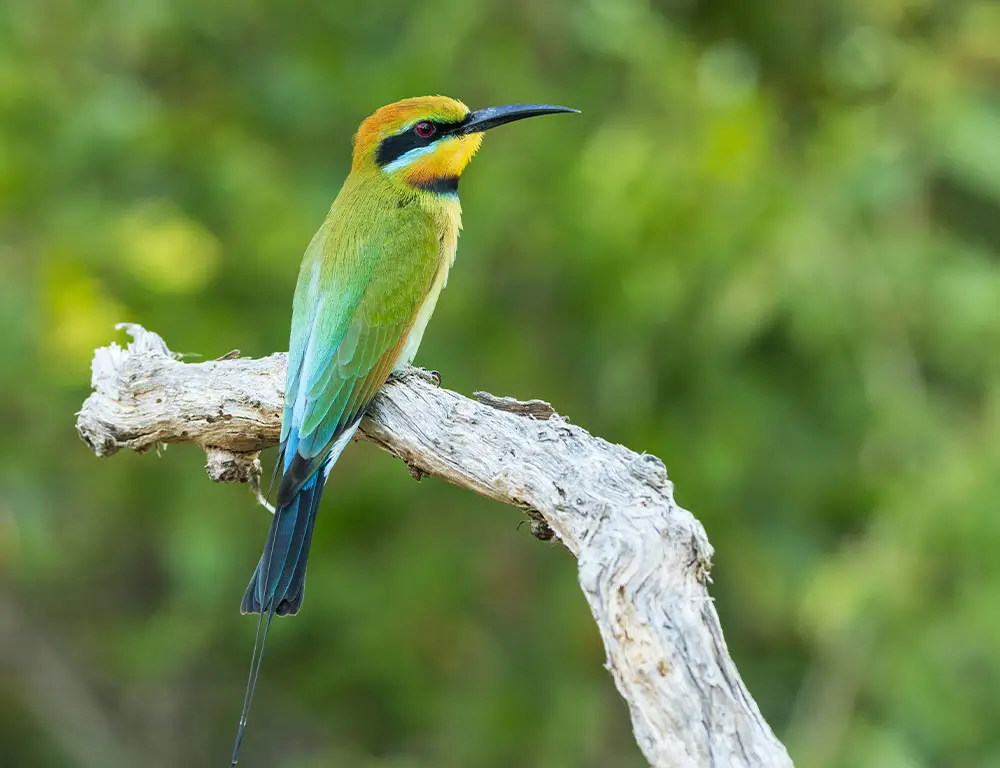
Physical Characteristics of the Bee-Eater
Bee-Eaters are a group of strikingly colorful birds known for their aerial prowess and specialized diet. Let’s delve into their physical characteristics and fascinating habits.
Vibrant Plumage
Bee-Eaters are adorned with vibrant plumage, often featuring combinations of green, blue, yellow, and chestnut hues. Their colorful appearance makes them stand out against the backdrop of the sky as they soar and dive in pursuit of insects.
Slender Body
These birds have a streamlined and slender body, facilitating their agile flight. Their aerodynamic shape allows them to perform intricate aerial maneuvers with ease.
Long, Pointed Wings
Bee-Eaters possess long, pointed wings, enabling them to glide effortlessly through the air. Their wingspan contributes to their excellent maneuverability and precision in catching flying insects.
Curved Bill
Bee-Eaters have a distinctive curved bill, ideally suited for catching and gripping insects mid-air. Their sharp bills are adapted to capture various flying prey, including bees, wasps, dragonflies, and butterflies.
Facial Features
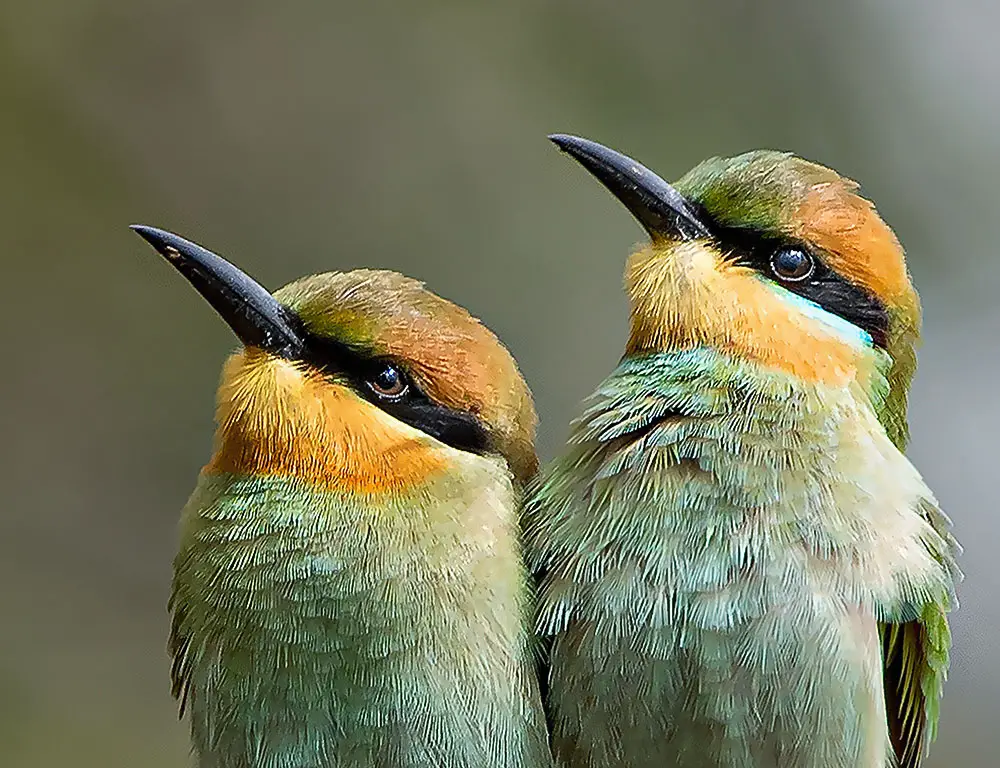
These birds typically have a slender necks, large eyes, and a short, slightly decurved bill. Their eyesight is highly developed, allowing them to spot insects from a distance and accurately target their prey during flight.
Aerial Foraging
Bee-Eaters are specialized insectivores, feeding on flying insects such as bees, wasps, and dragonflies. They hunt by performing aerial sallies, where they swoop down from perches or soar through the air to catch their prey with precision.
Colonial Nesting
Many species of Bee-Eaters are colonial nesters, congregating in large groups to breed and raise their young. They excavate nesting burrows in sandy banks or cliffs, where they lay their eggs and rear their chicks communally.
Courtship Displays
During the breeding season, Bee-Eaters engage in elaborate courtship displays, including aerial acrobatics, vocalizations, and ritualized behaviors. These displays serve to strengthen pair bonds and establish breeding territories.
Migration
Some species of Bee-Eaters are migratory, undertaking long-distance journeys between breeding and wintering grounds. Migration patterns vary depending on the species and geographic location, with some populations traveling thousands of kilometers annually.
Social Behavior
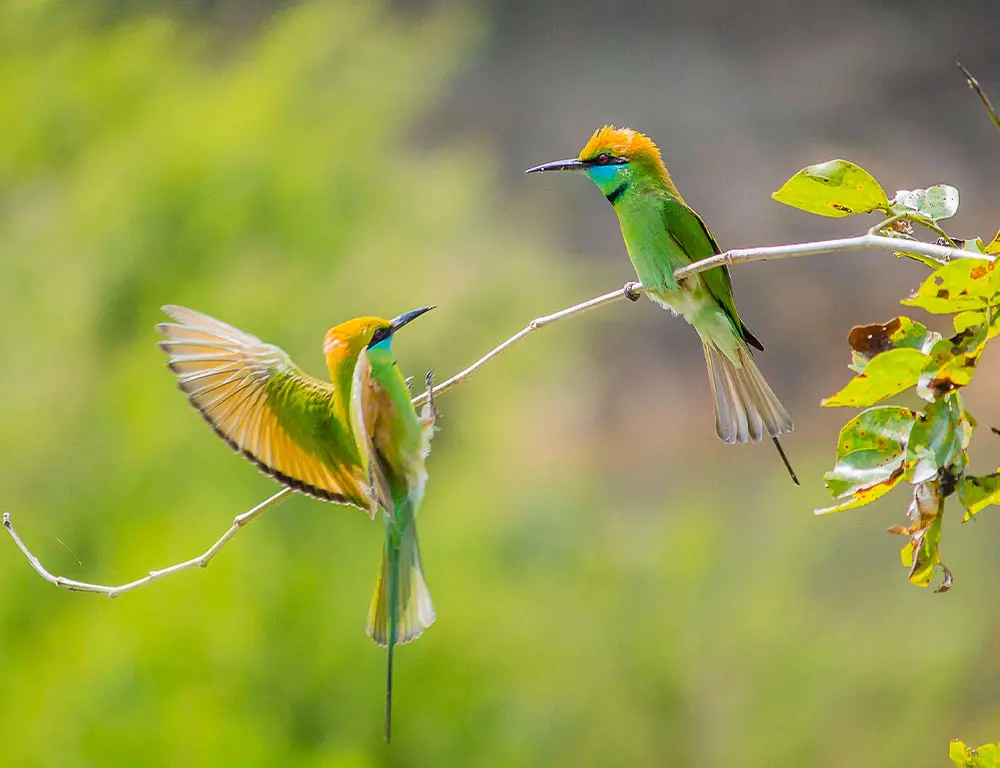
Bee-Eaters are often social birds, forming tight-knit family groups and flocks outside the breeding season.
They may roost together in communal roosts, where they gather in large numbers to rest and socialize before dispersing to forage during the day.
Taxonomy, Distribution, and Breeding Habits of the Bee-Eater
Delve into the fascinating world of Bee-Eaters as we explore their taxonomy, distribution, and breeding habits. From their colorful plumage to their specialized diet and nesting behaviors, Bee-Eaters offer a captivating glimpse into the diversity of avian life.
Taxonomy
| Taxonomy Level | Classification |
| Kingdom | Animalia |
| Phylum | Chordata |
| Class | Aves |
| Order | Coraciiformes |
| Family | Meropidae |
| Genus | Merops |
| Species | Varies by species |
Range Map
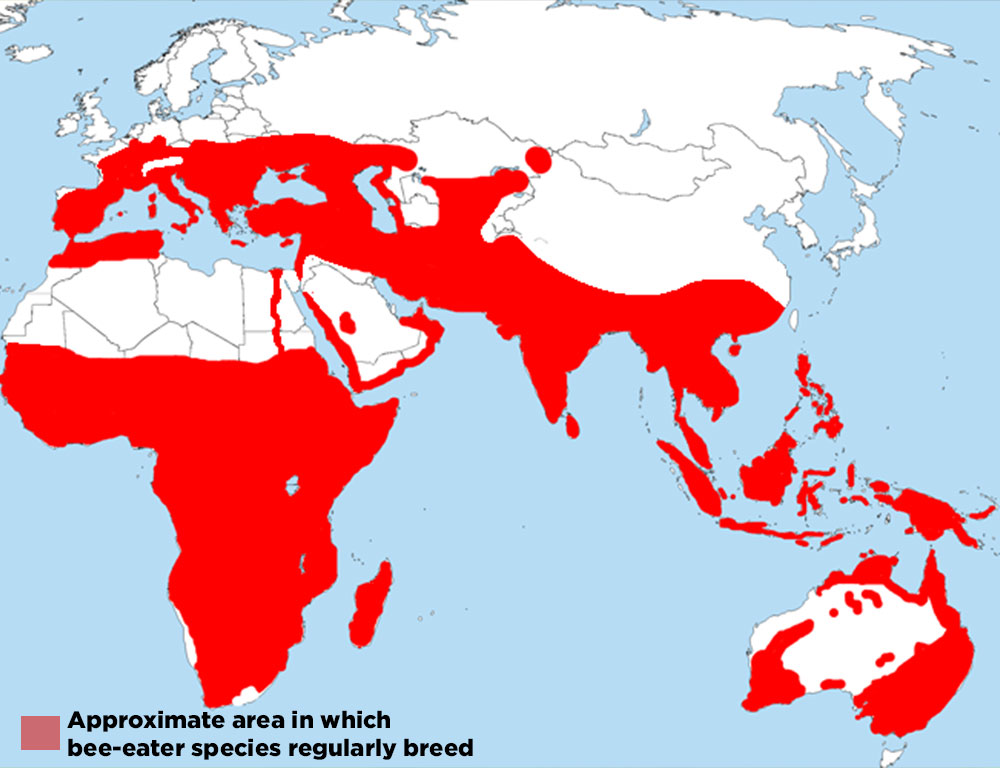
The range map illustrates Bee-Eaters’ distribution across their habitat range, including Europe, Africa, Asia, and Australia.
It highlights the areas where different species of Bee-Eaters are commonly found, providing insights into their geographic distribution and migratory patterns.
Food Habits
Bee-Eaters are primarily insectivorous, with a diet consisting mainly of flying insects such as bees, wasps, dragonflies, and butterflies. They catch their prey mid-air using specialized bills and aerial hunting techniques.
Nesting
| Nesting Habit | Description |
| Nest Location | Sandy banks, cliffs, or riverbanks |
| Nest Composition | Excavated burrows or tunnels in soft soil |
| Clutch Size | Typically contains 2-6 eggs |
| Incubation Period | Around 20-25 days |
| Parental Care | Both males and females share incubation and care |
Breeding
Bee-Eaters are typically monogamous and form pairs during the breeding season. They excavate nesting burrows in sandy banks, cliffs, or riverbanks, where the female lays a clutch of eggs.
Both parents share incubation and chick-rearing duties until the young fledge from the nest.
Diseases and Treatments
Bee-Eaters may face threats from diseases such as avian malaria, avian pox, and parasitic infections. Treatment options include veterinary care, antibiotics, antiparasitic medications, and supportive therapy to aid recovery.
Vigilant monitoring and management practices can help mitigate disease risks in Bee-Eater populations.
Is the Bee-Eater Endangered?
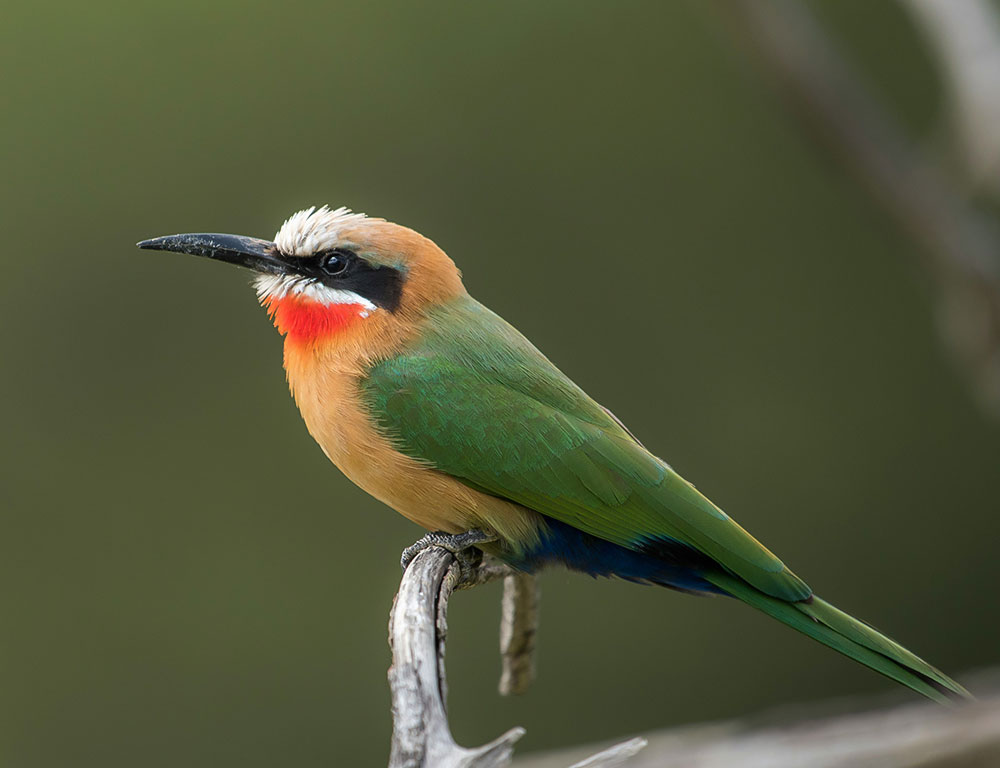
The conservation status of Bee-Eater species varies depending on the specific species and its geographic location.
While some species of Bee-Eaters are considered of least concern, others may face threats such as habitat loss, degradation, and fragmentation due to human activities such as deforestation, agricultural expansion, and urbanization.
Certain Bee-Eater species may also be impacted by climate change, affecting their breeding habitats and food availability.
Additionally, pesticide use and insect declines could impact their food sources, although this varies depending on local conditions.
While some Bee-Eater species may be at risk or experiencing population declines, others may remain relatively stable.
Monitoring their populations and habitats closely and implementing conservation measures to protect these colorful and charismatic birds and ensure their long-term survival is essential.
8 Interesting Facts About the Bee-Eaters
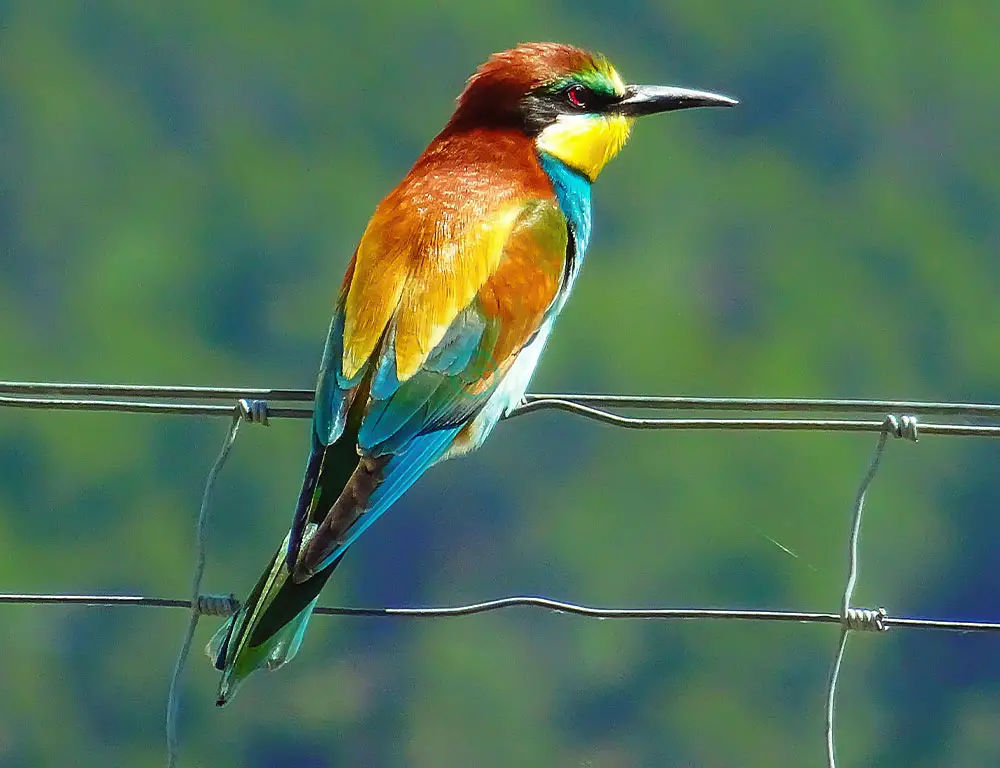
Embark on a journey of discovery as we unravel fascinating insights into the world of Bee-Eaters.
From their vibrant plumage to remarkable hunting techniques, Bee-Eaters are captivating birds that enchant and inspire. Let’s delve into eight intriguing facts about these aerial acrobats.
1. Colorful Bee Eaters
Bee Eaters are renowned for their stunning plumage, featuring vibrant combinations of green, blue, yellow, and chestnut hues. Their colorful appearance makes them a delight as they soar through the skies.
2. Specialized Diet
True to their name, Bee-Eaters feed on flying insects such as bees, wasps, dragonflies, and butterflies. They catch their prey in mid-air using their sharp bills and agile flight.
3. Aerial Acrobatics
Bee-eaters are skilled aerial hunters, performing impressive maneuvers as they swoop and dive to catch their prey. Their agility and precision in flight make them formidable predators of flying insects.
4. Colonial Nesters
Many Bee-Eater species are colonial nesters, congregating in large groups to breed and raise their young. They excavate nesting burrows in sandy banks or cliffs, creating bustling colonies during the breeding season.
5. Migration
Some Bee-Eater species are migratory, undertaking long-distance journeys between breeding and wintering grounds. Their migratory patterns vary depending on the species and geographic location.
6. Courtship Displays
Bee-Eaters engage in elaborate courtship displays during the breeding season, including aerial acrobatics, vocalizations, and ritualized behaviors. These displays serve to strengthen pair bonds and establish breeding territories.
7. Parental Care
Both male and female Bee-Eaters share incubation and chick-rearing duties, demonstrating cooperative breeding behavior. This shared responsibility contributes to the success of their offspring and strengthens pair bonds.
8. Cultural Significance
Bee-Eaters hold cultural significance in various societies, symbolizing agility, adaptability, and beauty. They feature prominently in folklore, art, and literature, reflecting their allure and charisma as birds of legend and lore.
FAQs
What is a Bee-Eater?
Bee-Eaters are a group of colorful birds belonging to the family Meropidae, known for their vibrant plumage and specialized diet of flying insects, including bees, wasps, and dragonflies.
Where do Bee-Eaters live?
Bee-Eaters are found in various habitats across Europe, Africa, Asia, and Australia. They inhabit open woodlands, scrublands, savannas, and grasslands, often near bodies of water where they can find suitable nesting sites.
How do Bee-Eaters catch their prey?
Bee-Eaters are skilled aerial hunters, catching flying insects such as bees and wasps in mid-air. They use their sharp, slender bills to snatch insects on the wing, performing agile maneuvers as they swoop and dive to capture their prey.
Are Bee-Eaters social birds?
Many Bee-Eater species exhibit social behavior, forming colonies during the breeding season where they nest and raise their young communally. They may also roost together in large groups outside of the breeding season.
Are Bee-Eaters migratory birds?
While some Bee-Eater species are migratory and undertake long-distance migrations between breeding and wintering grounds, others are passive and remain in their breeding range year-round. Migration patterns vary depending on the species and geographic location.
Conclusion
To wrap it up, Bee-Eaters are remarkable ambassadors of nature’s beauty and complexity. Their vibrant plumage and aerial acrobatics inspire awe and admiration, showcasing the elegance and ingenuity of avian evolution.
Beyond their aesthetic appeal, Bee-Eaters play a crucial role in maintaining the balance of ecosystems by regulating insect populations, particularly bees and wasps.
As stewards of the environment, we are responsible for ensuring the conservation of Bee-Eaters and their habitats. So, let’s join hands to protect them.
By protecting their nesting sites, preserving natural landscapes, and promoting sustainable insect control practices, we can safeguard the future of these captivating birds and the ecosystems they inhabit.
Let us continue to marvel at the splendor of Bee-Eaters and strive to coexist harmoniously with the natural world, recognizing the interconnectedness of all living beings and the importance of biodiversity conservation for generations to come.